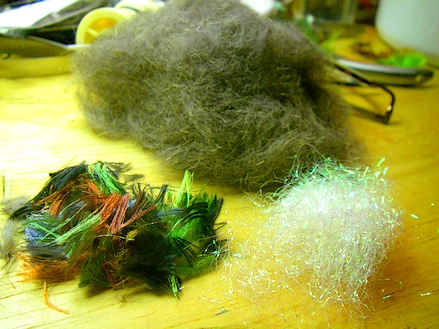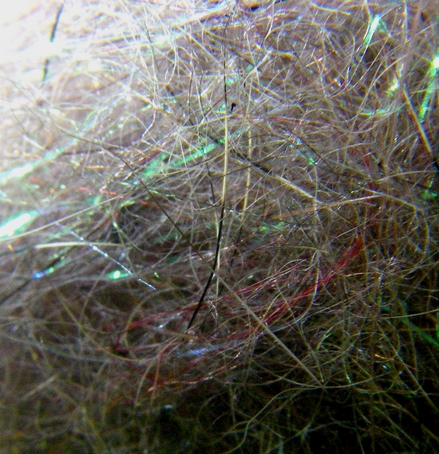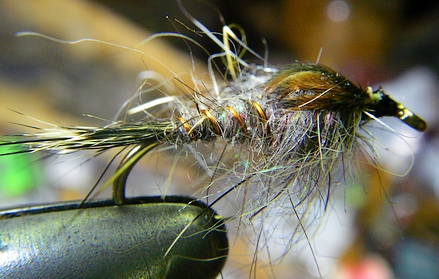Somewhere some poor fellow is crouched over his vice cursing a blue streak, all he needs is a Halloween Orange or black spey hackle and the fly in his head becomes reality. It’s the classic frustrated artist, on the verge of greatness and the drawer yields nothing but earth tones of wool or polypropylene – none of which possess the qualities he so desperately needs.
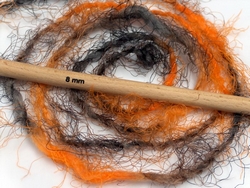
So is it the fear of entering a store full of women that’s his undoing? One of his pals is likely to see him talking to the counter help discussing the relative merits of flag versus eyelash?
… and why is it that fly shops insist on stocking a token contingent of lifeless wool in muted earth tones? There’s plenty of natural fur in the same colors further down the aisle, the wool doesn’t sell worth beans, has poor tying properties, and is so common that even we know three yards for a buck is a waste.
It’s what we don’t know about that could be really useful, usually we stumble upon it while standing at the end of the aisle, her purse in hand, giving the “I’m with Madam” look to quizzical bystanders.
Guys have always prided themselves by calculated shopping, and cannot abide the poking, prodding, browsing, got-to-touch-it method that gals practice.
Sorry, Sweetness. If you want the “good stuff” you’re going to have to earn it.
Yarns have three basic fly tying properties; the wrap, rend, and the comb:
Wrap: the most obvious, what you wind up with if you wrap it around the hook shank.
Rend: what it becomes when you cut it into 1″ pieces and tear it apart in a coffee mill.
Comb: How spiky it is when wrapped around a hook shank then combed with Velcro.
Size, shape, and texture are described by the yarn itself, often using reserved words familiar to knitters and the millinery crowd, like: Boucle, Chenille, Mohair, Flag, Ribbon, Eyelash, and countless others.
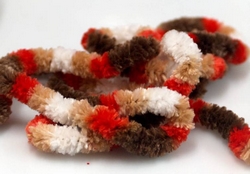
What’s apparent is many of these odd styles offer some streamlining of the fly tying process. They’re not just body materials any longer, many provide hackle, wingcase, or other detail at the same time.
The variegated Orange eyelash yarn above can tie a spey fly with better movement than heron hackle. Yarn fibers are “loosely coupled” rather than affixed to a rigid and brittle stem – and while the rest of the fly tying world seeks the next emu saddle or dyed pheasant heron replacement – you can enjoy 80 yards of uniform sized spey hackle for about ninety eight cents.
It’s tough being so narrowly focused on endangered wildlife especially when your wife solves your problem in the millinery aisle.
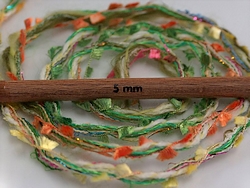
Perhaps it’s why the lament about “nothing new” is oft heard, we killed and pelted anything bigger than a fingernail, and the physical restrictions of bird feathers and natural fur have been well defined in the last couple hundred years.
What we’ve got that they didn’t have is synthetics – and they’re just as varied and colorful as exotic birds, something I’ve been dabbling in while my compatriots focus on perfumed emu bottom.
There’s hundreds of thousands of yarns currently available, and many more hundreds of thousands of colors and textures made in the last couple of years. So many that you cannot possibly see them all.
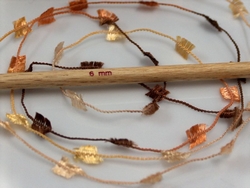
Fashion dictates what’s made and in what colors, and with the short lifespan of garments, you may only stumble on a handful before they’re no longer made.
Yarndex.com is an attempt to catalog every yarn ever made – and is an indispensable resource for finding both manufacturer and what colors were made in which year.
Like automobiles many manufacturers only release certain colors in certain years. Finding that “perfect” olive color might be a couple years too late – with only eBay as a potential source. Yarndex displays a dated color card for each year of manufacture – and also will tell you whether it’s currently in production.
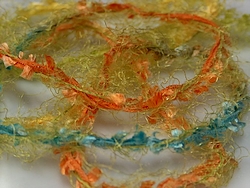
I’ve intentionally narrowed my project to cover qualities that Mother Nature’s materials often lack, movement and vibrant colors. Birds and beasts possess many colors on an single skin, but most are hues of a single color like Brown, Gray, or Tan. Those that don’t are illegal to import, possess, and are worth many dollars per feather…
Steelhead, Salmon, Shad, Bass, and most saltwater flies are quite colorful, sometimes a range of colors is better suited than a range of hues, and the synthetic qualities of some yarns lend themselves to better uses than natural materials.
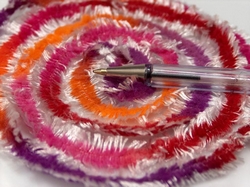
I am a self professed fiend of “mutt” yarns, they look like junkyard dogs with splotches of color and odd shapes that when wrapped, shredded, or combed, yield something terribly special.
Even trout flies, that bastion of somber and muted earth tones, is no longer safe. While the rest of the crowd fiddles with the traditional droll materials, us “colorful” types get to fiddle with imbedded tinsel, mylar, strung beads, and lumpy yarns – causing the snobs to blow tea out of their collective noses …
… ’cause in the millinery aisle, that’s how we roll …
I’m still working my way through my last shipment from Turkey (via Yarn Paradise’s eBay store) and I’ve got additional piles of promising shapes and colors readied for a couple of months of “fiddling.”
 We touched on fur blends and how they’re constructed, with yarns I’ll use “sympathetic” fur blends. Small flies can benefit from yarns as well as large – but small fly construction doesn’t lend itself to a big hammy handed yarn wrap, many components are better suited for rending yarn, as it minimizes bulk and requires less thread to tie it off.
We touched on fur blends and how they’re constructed, with yarns I’ll use “sympathetic” fur blends. Small flies can benefit from yarns as well as large – but small fly construction doesn’t lend itself to a big hammy handed yarn wrap, many components are better suited for rending yarn, as it minimizes bulk and requires less thread to tie it off.
I’ll take a base of natural fur in a neutral color (typically gray) and mix in enough of the chopped and milled yarn to make it a shade of the yarn color. “Binder” is best suited as the natural component because many yarns when shredded are coarse – the binder tames them into an easily dubbed blend.
Mutt yarns require intestinal fortitude because they violate all the principles and tenets you’ve learned. No two flies look the same – so the security blanket of “I just caught six on the same fly” is removed. Even though you’ve tied six dozen, the fear that “they liked the one with more yellow” is very real.
Fish are stupid, and you’re the Scourge of the Fabric Outlet, stride with confidence…
A well matched mutt yarn can save a tyer both time and effort, but finding the perfect yarn remains the most difficult task. Most craft superstores carry less than 1% of what’s available, eBay lists 12,000 different entries for “yarn” – but still isn’t more than 5% of what’s been made in the last couple of years.
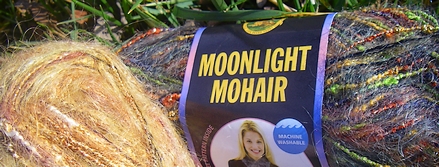
The ultimate Mutt is “Moonlight Mohair”, two separate yarns wound as a single strand, together offering a stunning mixture of tinsel, thread core, and a limitless source of mohair dubbing.
The above left is my Golden Stone nymph color, and the one on the right is a leech-steelhead candidate. The golden color offers a half dozen shades of golden brown, gold, tan, and dark brown – wrapped over a black thread core, and complimented by another strand of gold tinsel-infused brown, gold, and dark brown wound over a white cotton core. Both strands wrapped together is the best golden stonefly nymph color I’ve ever seen.
A golden stone isn’t really “golden” – so much as it’s mottled in a very pronounced fashion. A mixture of dark bug with light yellowish highlights on wingcases, legs, and each ring of its abdomen. It cannot be matched by any single color – which is true of most underwater insects.
I got lucky, this was thrust under my nose while I toe tapped impatiently waiting for my gal – who was feeling her way through the millinery aisle and spotted something uncommon.
I felt the same thing … uncommonly lucky … about the gal. The yarn was superb too …
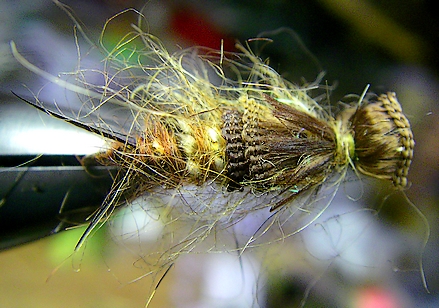
Only the tail on the above “Golden Mutt” isn’t yarn. Wingcases and hood over the bead are Bernat Boa Eyelash yarn – I like its pronounced stitching as a wingcase effect.
The Moonlight Mohair body shows the multiple brown and gold colors with bits of gold tinsel and white cotton core. The black thread that binds the mix is quite pronounced and will show at interval.
The above picture shows the “comb” of the yarn – once the body is wrapped, I comb the mixture to pull loose the mohair fibers and give the fly its shaggy appearance. Under the wingcase is a sympathetic blend of yarn fragments and gray beaver as binder – it’s indistinguishable from the rest of the fly. Mohair is a wonderful spiky dubbing unto itself, the beaver merely makes the unruly into well behaved.
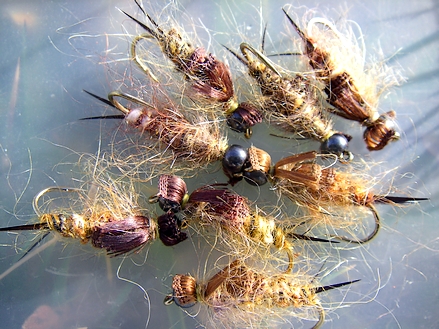
Us millinery store aficionados are in touch with the inner female, we’ve learned to poke and prod our way through the yarn aisle with aplomb. Unshaven, unruly, yesterday’s shirt hanging out – it’s unfortunate that a little beaver can’t do the same for us.
The gaggle of Golden Mutt’s above show that no two flies are identical, the sign of the true mutt. Note the visible black thread in the body and the color of the blended fur under the wingcases.
Moonlight Mohair is available in the craft store for $9 per skein. I prefer to buy it on ebay, where the price is about 1/3 retail. The above golden stone color is called “Safari” – the color next to it is “Rain Forest.”
… and the next time I hear some fellow pronouncing “their ain’t been anything new in fly tying in the last forty years,” I’ll know I’m dealing with someone who can’t think outside the feather dander.
Synthetics are new – and if we added up all the fly tiers in the entire world, we’ve collectively seen about 10% of what’s available.
See you in the sequin section, Sweetpea …
Technorati Tags:
Midnight Mohair,
Boucle,
Eyelash yarn,
Butterfly,
flag,
mohair,
yarn,
hue,
shades,
Bernat Boa,
Golden Stone,
Golden Mutt,
mutt yarn
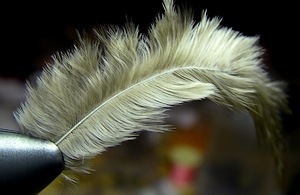 With all the pressing chores finished I started working on the Caddis flies. I’d been sidetracked by an “old school” reference to Polly Rosborough – whose fur collared flies reminded me of Jack Gartside’s Sparrow nymph, which suggested Cal Bird’s woven bodies, and the drone of Clint Eastwood Spaghetti Westerns hummed in the background while I rediscovered my attraction to Philoplumes.
With all the pressing chores finished I started working on the Caddis flies. I’d been sidetracked by an “old school” reference to Polly Rosborough – whose fur collared flies reminded me of Jack Gartside’s Sparrow nymph, which suggested Cal Bird’s woven bodies, and the drone of Clint Eastwood Spaghetti Westerns hummed in the background while I rediscovered my attraction to Philoplumes.



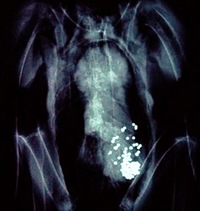


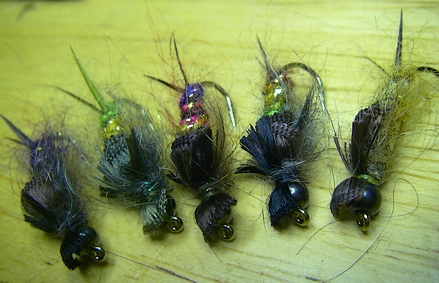

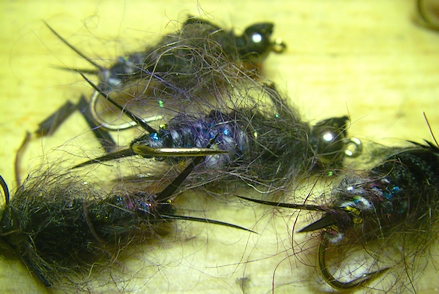
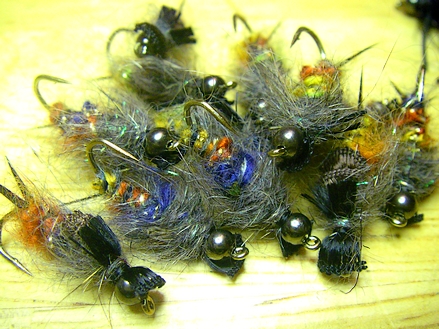
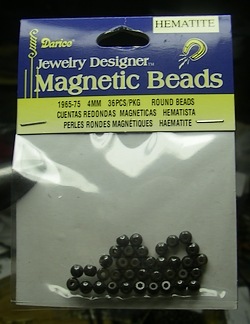 I was beginning to think stern looks from anglers were due to the similarities fly fishing has with the workplace. Guys on vacation smile and hold a dripping fish close to their chest, but guys at work thrust it towards the lens to look focused and professional.
I was beginning to think stern looks from anglers were due to the similarities fly fishing has with the workplace. Guys on vacation smile and hold a dripping fish close to their chest, but guys at work thrust it towards the lens to look focused and professional.





 We touched on fur blends and how they’re constructed, with yarns I’ll use “sympathetic” fur blends. Small flies can benefit from yarns as well as large – but small fly construction doesn’t lend itself to a big hammy handed yarn wrap, many components are better suited for rending yarn, as it minimizes bulk and requires less thread to tie it off.
We touched on fur blends and how they’re constructed, with yarns I’ll use “sympathetic” fur blends. Small flies can benefit from yarns as well as large – but small fly construction doesn’t lend itself to a big hammy handed yarn wrap, many components are better suited for rending yarn, as it minimizes bulk and requires less thread to tie it off.


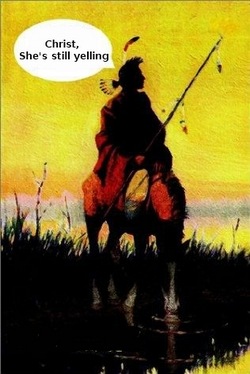 I get one of those hushed phone calls from “Mr. X” this weekend, I’m in between refills of the spinach dip – after a long trek up the creek that morning, and I’m thinking a serving of couch and Superbowl may be warranted.
I get one of those hushed phone calls from “Mr. X” this weekend, I’m in between refills of the spinach dip – after a long trek up the creek that morning, and I’m thinking a serving of couch and Superbowl may be warranted.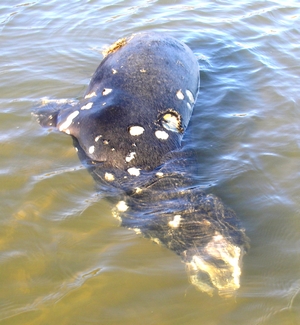 I’ve changed my mind and revoke all style points awarded this weekend.
I’ve changed my mind and revoke all style points awarded this weekend.
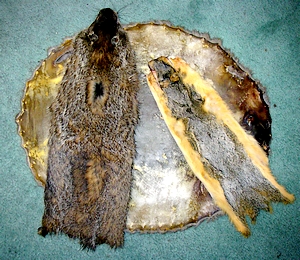 Us impressionists are a tough crowd, you’ll regret us painting your house because of all the spots we miss – but we’ll march you across the street and insist the color looks fine.
Us impressionists are a tough crowd, you’ll regret us painting your house because of all the spots we miss – but we’ll march you across the street and insist the color looks fine.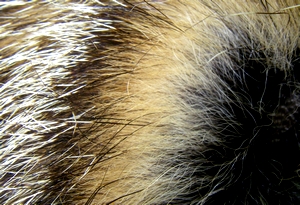 Wrapper: Wrapper is present on blends for larger flies and can be omitted for building fine dry fly dubbing. Wrapper is usually an animal that has pronounced guard hairs – often with a light band that can absorb dye. It provides “spike” to the blend and breaks up the uniformity of the other two furs.
Wrapper: Wrapper is present on blends for larger flies and can be omitted for building fine dry fly dubbing. Wrapper is usually an animal that has pronounced guard hairs – often with a light band that can absorb dye. It provides “spike” to the blend and breaks up the uniformity of the other two furs.